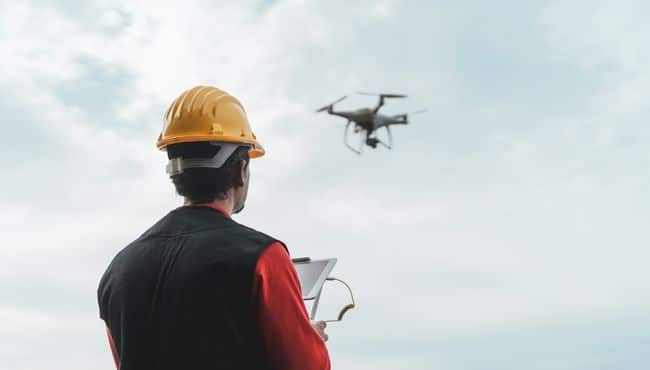Power line inspection is a task that requires the use of specialised equipment and expertise to ensure that they are inspected thoroughly. It’s also a job that can be hazardous and very challenging, especially if the terrain is difficult to traverse and weather conditions are not the most favourable. To improve their work and optimize the efficiency of their operations, power companies are starting to use drones to inspect power lines, this is proving to have many benefits, these include faster inspection times, accurate data acquisition, safer working conditions and saving on costs. Here’s everything you need to know about using drones for power line inspection.
Benefits Of Using Drones For Power Line Inspection
Drones provide many benefits for power line inspection, the main one is that it reduces the need for workers to physically inspect these cables, thus minimising the risk of injury or electric shock.
Power line inspections are needed to be carried out on a regular basis for maintenance purposes and to comply with the law.
A lot of time, an inspection of any kind of infrastructure does not lead to any kind of maintenance requirements, however, for regulatory purposes, power companies need to carry out inspections on a regular basis.
This has a huge effect on their budget and resources as they may need to hire equipment like mobile elevating work platforms, scaffolding or even a small manned aircraft.
Manual Inspection of any kind of infrastructure can be time-consuming and, in many instances, it is a risky job.
The risk factor is increased if it involves climbing pylons or other structures of great height, these types of jobs are some of the most dangerous in the world.
According to this article from the University of Delaware, there are approximately 20 deaths per 100,000 workers in power line maintenance work. There are also serious injuries associated with these types of jobs that are most likely much higher.
Advanced technology like drones can help reduce these deaths and injuries by allowing workers to inspect power lines and other types of infrastructure from a safe distance.
Drones will also eliminate the need to hire expensive equipment like mobile elevating platforms and small helicopters, which will help reduce costs and improve ROI.
Another benefit of drones is that they are small, lightweight and ultra-portable, they can be easily deployed whenever the need arises without the associated cost of purchasing or hiring additional equipment.
Regular inspection will help with catching any issues with power lines early before they become a serious problem and cause problems like power outages.
Data captured by drones can easily be shared with relevant parties which will allow for better communication between different departments and any necessary maintenance work can be planned and completed as soon as possible.
Another cost-saving benefit of using drones is that because they provide a safer means of inspection, the insurance costs will not be as high.
Best Drones For Power Line Inspection
The use of drone technology for inspection purposes is growing rapidly and there are a lot of options to choose from.
The best drones for any kind of inspection are ones that come equipped with a long flight time, a high-resolution RGB and a thermal imaging camera, has autonomous flight modes and can be operated in adverse weather conditions.
There are a lot of drones that come with the features and the list below is by no means an exhaustive list, however, they are some of the best enterprise-level drones on the market and are great for any kind of inspection job.
DJI M30/30T
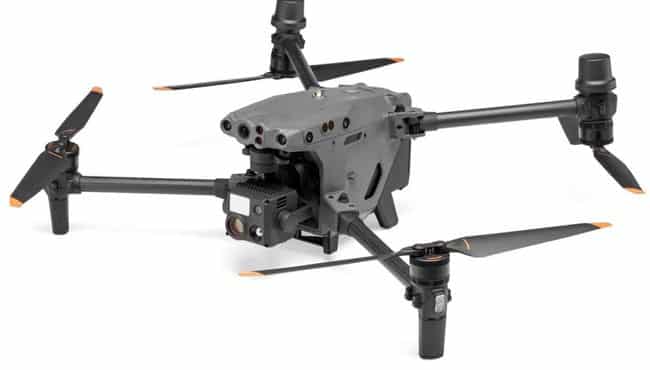 This is one of DJI’s latest enterprise-level drones, it’s a compact version of the Matrice 300 and comes with many of the same features. There are two versions of this drone, the one you should consider is the M30T as it comes with a high-resolution thermal imaging camera.
This is one of DJI’s latest enterprise-level drones, it’s a compact version of the Matrice 300 and comes with many of the same features. There are two versions of this drone, the one you should consider is the M30T as it comes with a high-resolution thermal imaging camera.
The DJI M30T is a foldable drone which makes it ultra-portable and easy to travel with, this makes it a great drone for inspection purposes.
The drone has an IP55 rating which will allow power line inspectors to use it in harsh weather conditions and it has multiple redundancy systems that will ensure all missions are completed even if a system fails. Other safety features include dual-vision sensors all around the drone and an ADS-B receiver that will alert the pilot of any nearby aircraft.
The M30T comes equipped with a multi-sensor payload that consists of a 48MP zoom camera, a 12MP wide camera, a thermal imaging camera with a maximum photo/video resolution of 1280×1024 and a laser range-finder. The drone also comes equipped with an FPV night-vison camera on the front.
The drone comes with 41 minutes of flight time and comes with DJI’s latest version of their OcuSync transmission system for a range of 15km which will be useful for companies that can obtain permission for BVLOS operations.
The remote controller for the M30T has a rugged design and comes with an IP54 rating. It comes with a high-luminance 7.2 LCD screen and runs on the Android operating system.
DJI Matrice 300 RTK
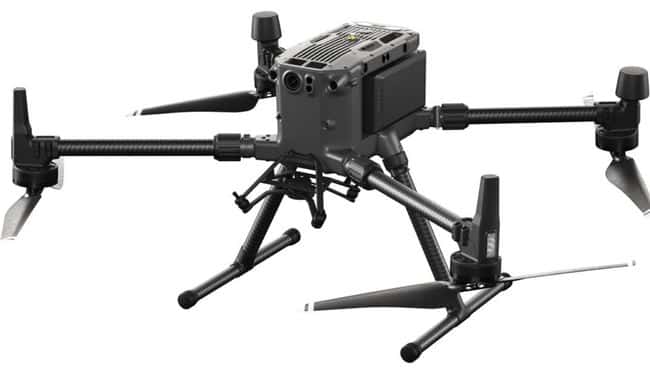 The Matric e 300 RTK is the most advanced in the Matrice series of enterprise-level drones. It is a large drone that comes with retractable rotor arms which makes it easier to pack and travel with. The drone comes with an IP45 rating making water resistant which allows it to be operated in diverse weather conditions. The drone comes with several safety features which include vision sensors on all sides, multiple redundancy systems, DJI AirSense and for additional safety, the Matrice 300 RTK can be fitted with DJI’s CSM Radar module which provides the drone with complete obstacle detection and avoidance.
The Matric e 300 RTK is the most advanced in the Matrice series of enterprise-level drones. It is a large drone that comes with retractable rotor arms which makes it easier to pack and travel with. The drone comes with an IP45 rating making water resistant which allows it to be operated in diverse weather conditions. The drone comes with several safety features which include vision sensors on all sides, multiple redundancy systems, DJI AirSense and for additional safety, the Matrice 300 RTK can be fitted with DJI’s CSM Radar module which provides the drone with complete obstacle detection and avoidance.
An innovative feature of this drone is that it can carry multiple payloads which makes it a very versatile drone that can be used for many commercial applications.
One of the best cameras for the Matrice 300RTK is the DJI Zenmuse H20T which is a multi-sensor payload that comes with a high-resolution zoom, wide and thermal imaging camera and also has a laser range-finder.
The drone can also be attached with third-party payloads that will extend its functionality and allow it to be used in different scenarios.
The drone has a flight time of 55 minutes, however, this can only be achieved when there is no payload attached. Its flight time with the Zenmuse H20T will be around 40 minutes, while something lighter like the XT2, it can achieve around 46 minutes of flight time.
The flight time will depend on the type of payload that will be used, the mission purpose and weather conditions.
DJI Mavic 2 Enterprise Advanced
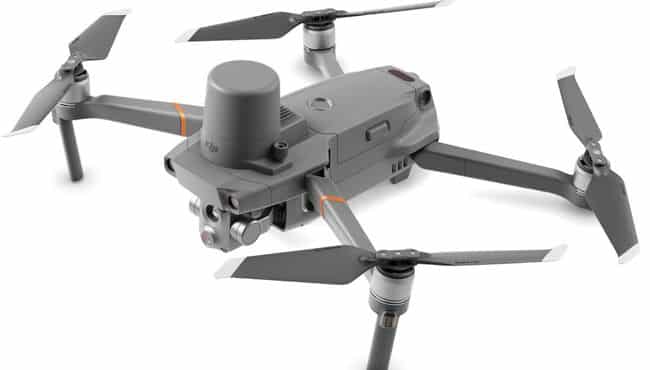 One of the best compact drones on the market, the DJI Mavic 2 EA has been designed for industrial inspection. The drone weighs less than 1kg, making it one of the lightest enterprise-level drones and easy to travel with.
One of the best compact drones on the market, the DJI Mavic 2 EA has been designed for industrial inspection. The drone weighs less than 1kg, making it one of the lightest enterprise-level drones and easy to travel with.
The drone is equipped with a dual-camera system that consists of a 48MP RGB camera that can record 4k video footage and has a 32× digital zoom function and the other is a high-resolution thermal camera that comes with 16× zoom.
The dual camera system is stabilised by a 3-axis gimbal and the drone can be operated in very hot and cold climates, however, it is not water resistant and has a level 5 wind rating, so its use will be limited by certain weather conditions.
The drone comes with an omnidirectional obstacle avoidance system and can be fitted with an anti-collision beacon for night-time operations. The drone can be attached with some additional accessories like a searchlight, RTK module and speakers for different mission scenarios.
The drone comes with a maximum flight time of 30 minutes and has a video transmission range of 10km.
Autel EVO II Dual 640T
 Autel Robotics are a well-known consumer drone brand, however, recently they have released a few enterprise-level drones and one of them is the EVO II Dual 640T.
Autel Robotics are a well-known consumer drone brand, however, recently they have released a few enterprise-level drones and one of them is the EVO II Dual 640T.
This is a dual-camera drone that comes with an impressive RGB camera that can capture 48MP images and record 4k videos. The camera has multiple photography modes including Hyperlight and HDR that will provide detailed images in low-light conditions. The camera also has 16× zoom and 4× lossless zoom which will be useful for any kind of inspection job.
There is also a thermal camera that has a 640×512 video resolution and also comes with 16× digital zoom. The drone has a level 8 wind resistance and can be operated in temperatures between -10°C and 40°C.
It comes with some advanced features such as an omnidirectional obstacle avoidance system, and autonomous flight modes and has a flight time of 38 minutes and transmission range of 9km.
Parrot Anafi USA
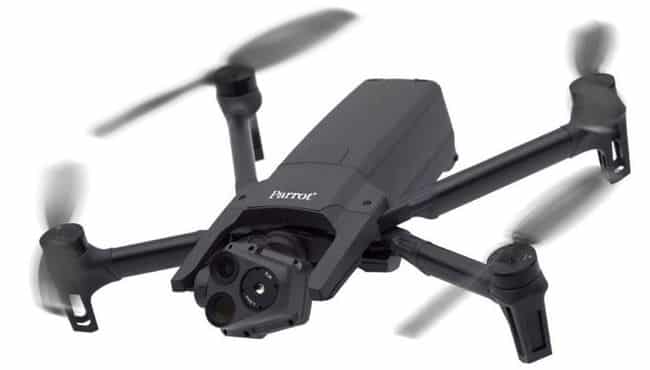 Developed specifically for use in the USA, this drone is approved by the Blue sUAS program which means it meets the requirements to be used by the US DoD. This is a lightweight drone that comes with some powerful features and has an IP54 rating which allows it to be operated in wet conditions.
Developed specifically for use in the USA, this drone is approved by the Blue sUAS program which means it meets the requirements to be used by the US DoD. This is a lightweight drone that comes with some powerful features and has an IP54 rating which allows it to be operated in wet conditions.
The drone comes with a 21MP RGB camera and a FLIR thermal camera that has a maximum video resolution of 1280×720.
The drone has a flight time of 32 minutes and a maximum transmission range of 5km
Final Thoughts
Although this article talks about the benefits of drones for power line inspection, the same benefits apply to most other types of inspection, whether it’s inspecting large power plants, rooftops, bridges, oil rigs etc. Drone inspection will help reduce deaths, injuries and costs whilst improving efficiency, productivity and ROI.

